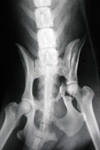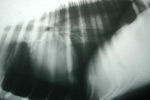The Patient
Unit 4: Preoperative Assessment & Management
Topic 2: Physical Examination
The importance of a thorough clinical examination
The physical examination should include an examination of all body systems and not just the obvious lesion. This is a very important consideration in dealing with traumatic injuries. For example it has been established that up to 40% of animals that are presented with forelimb fractures also have significant thoracic trauma.
Whilst a fracture in the limb may be obvious, it will rarely result in the death of the animal. A developing pneumothorax on the other hand is frequently life threatening
All cases, no matter how obvious the diagnosis may appear, deserve a decent and thorough clinical examination.
Avoid the embarrassment of overlooking important lesions in other body systems!
Know the normal:
No clinical examination is superfluous, it gives you yet another chance to brush up on what is normal.
As students and recent graduates, you are still learning what is normal. Take every opportunity to become familiar with the normal.
The aim of a general clinical system is to detect any abnormality in any of the bodily systems. This may then lead to the need to examine one or more systems in greater detail. In a similar way as taking a history, it is useful to develop a system, so that no area is overlooked.
A systematic examination becomes an automatic routine and need not be time-consuming.
Examination at a distance :
Much can be learned from this. With small animals this is done as animals enter from the waiting room and while the history is being taken. For large animals, inspection in the yards, box or even in the paddock is useful. Examination at a distance gives useful information about:
- Behaviour, alertness
- Conformation
- Posture, stance and gait
- General physical condition
Also, for farm animals, take note of :
- Whether eating
- Evidence of defaecation and urination
- Husbandry conditions
Physical Examination
The examination routine varies from species to species, but only in minor practical detail. It is essential to epeatedly practice an orderly routine until you find it has become "second nature" to you.
Don't be tempted to "short cut" to obvious lesions as this will surely lead to omission of important signs!
Use bodily symmetry to your advantage. Compare limbs, joints, muscles, sides of thorax etc. to help judge what is/isn't normal.
A common small animal examination routine is as follows:
- 1) Rear end:
- Temperature
- Anus, anal sacs, perineum
- external genitalia
- Skin of tail, perineum, thighs
- local lymph nodes
- femoral pulses
- 2) Head:
- Eyes - compare!
- Pupil size, PLR.
- Conjunctivae & Corneas
- Nose
- Lip folds/skin
- Labial and buccal mucosae
- Teeth
- Tongue
- Oropharynx and tonsils
- Ears
- External palpation of neck/pharynx
- 3) Skin, trunk extremities:
- All superficial lymph nodes
- Mammae
- Prepuce
- Feet, pads, claws
- Skin turgor
- 4)Thorax:
- Evenness of respiration
- Nature of respiratory cycle
- Lung auscultation
- Percussion
- Cardiac auscultation
- 5) Abdomen
- General shape: distended, tucked up
- Ballotment: fluid
- Palpation
- pain/guarding
- identify organs: - liver
- spleen
- bowel loops
- colon
- kidneys
- bladder
- uterus
- prostate
- 6) Musculoskeletal:
- Observe gait/posture as part of general examination
- General palpation for symmetry
- Specific joint/muscle palpation and manipulation as required.
- 7) Nervous System:
- Mental state/alertness
- Posture and gait
- Paresis/paralysis
- Ataxia
At the conclusion of your general examination you should have made a decision:
- The patient is normal... OR
- The patient is abnormal and I know what is wrong.
I can proceed to advice and treatment... OR
- The patient is abnormal but I do not know enough about the problem yet.
I may need to do further detailed system examinations or perform appropriate diagnostic tests.

- Radostits, Blood and Gay: Veterinary Medicine 8th Ed 1995 Balleau Tindall. Chapter 1 - Clinical Examination and making a diagnosis.
- Sherding RG. The Cat, Diseases and Clinical Management 2nd Ed 1994 Churchill Livingstone Inc. Chapter 2- The Medical History, Physical Examination and Physical Restraint.
- Lorenz M.D. and Cornelius, L.M. Small Animal Medical Diagnosis 2nd Ed, 1993, Lippincott. Chapter 1 - The Problem - Oriented Approach
- Morgan, R.V. Handbook of Small Animal Practice. 3rd Ed 1997 WB Saunders Co P. 3-11 - General Physical Examination of the Dog and Cat.

